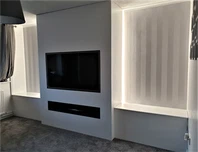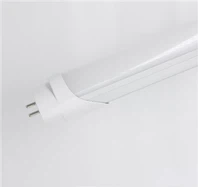DALI Lighting Control: The Complete Guide
 DALI (Digital Addressable Lighting Interface) represents a significant advancement in lighting control technology. As an open, manufacturer-independent standard, it provides sophisticated digital control while maintaining straightforward installation and configuration. This protocol has become the preferred choice for commercial spaces, hospitality venues, and large residential projects seeking intelligent lighting solutions.
DALI (Digital Addressable Lighting Interface) represents a significant advancement in lighting control technology. As an open, manufacturer-independent standard, it provides sophisticated digital control while maintaining straightforward installation and configuration. This protocol has become the preferred choice for commercial spaces, hospitality venues, and large residential projects seeking intelligent lighting solutions.
Understanding DALI Technology
DALI is a two-way digital communication protocol specifically designed for lighting control systems in building automation. Unlike traditional one-way control methods, DALI enables bidirectional communication between controllers and individual lighting devices. This allows for not only sending commands but also receiving status updates and diagnostic information from each connected fixture.
The protocol originated as an enhancement to Tridonic's Digital Serial Interface and has evolved into an international standard (IEC 62386), ensuring compatibility across manufacturers and future-proofing installations.
Key Advantages of DALI Systems
Unmatched Flexibility
DALI's addressable architecture allows individual control of up to 64 devices on a single bus. Lighting groups and scenes can be reconfigured through software without physical rewiring, making it ideal for spaces with changing requirements.
Simplified Installation
The standardized two-wire bus system eliminates complex wiring configurations. Installers don't need to know the final lighting arrangement during installation, as addressing and grouping are handled digitally after physical installation.
Open Standard Compatibility
As a vendor-neutral protocol, DALI ensures interoperability between components from different manufacturers. This prevents vendor lock-in and provides access to competitive pricing while maintaining system integrity.
Comprehensive Monitoring and Control
Facility managers benefit from real-time status monitoring of individual fixtures, enabling predictive maintenance and rapid fault identification. Energy consumption tracking and automated lighting schedules further enhance operational efficiency.
Scalable Architecture
From single-room installations to multi-building complexes, DALI scales effortlessly. Multiple DALI buses can be networked together to create comprehensive lighting management systems for any scale of project.
System Components and Architecture
DALI Bus Structure
The backbone of any DALI installation is its two-wire bus, carrying both power and digital communication. This low-voltage bus connects all system components:
Control gear (LED drivers, ballasts)
Input devices (sensors, switches)
Application controllers
Addressing Scheme
Each device on the DALI bus receives a unique address (1-64), while groups can be defined to control multiple devices simultaneously. Broadcast commands can also address all devices on the bus when needed.
Control Options
DALI supports diverse control interfaces:
Wall-mounted dimmers and switches
Occupancy and daylight sensors
Centralized management software
Integration with building automation systems
Mobile and web-based interfaces
Installation and Configuration
Wiring Simplicity
The two-wire bus topology significantly reduces installation complexity compared to conventional lighting control systems. Standard low-voltage cable runs between devices in a daisy-chain configuration, with no special shielding requirements.
Commissioning Process
After physical installation, system configuration occurs through software:
Device addressing and identification
Group assignment
Scene programming
Control device mapping
System verification and testing
This digital commissioning allows for easy reconfiguration as space requirements evolve, without requiring physical changes to the installation.
Integration Capabilities
Building Automation Systems
DALI seamlessly integrates with major building management platforms including Lutron, KNX, and BACnet. This enables unified control of lighting alongside HVAC, security, and other building systems.
Hybrid Configurations
Combining DALI with other control protocols can optimize both functionality and cost. Common integration scenarios include:
DALI for lighting control with KNX for overall building management
RF wireless extensions for retrofit applications
IoT platform connectivity for cloud-based management
Application Scenarios
Commercial Offices
Individual workspace lighting control
Meeting room scene presets
Corridor and common area automation
Energy management through occupancy and daylight harvesting
Retail Environments
Flexible merchandise highlighting
Seasonal lighting adjustments
Operating hour automation
Energy usage optimization
Hospitality Venues
Guest room lighting scenes
Public area mood lighting
Restaurant and bar ambiance control
Facility-wide lighting schedules
Industrial Facilities
High-bay lighting zone control
Maintenance scheduling through usage monitoring
Safety and emergency lighting integration
Energy consumption tracking
Technical Specifications
Bus Voltage: 16V DC (nominal)
Maximum Devices per Bus: 64 control gear + 64 control devices
Wiring: Standard two-wire bus, polarity-insensitive
Data Rate: 1200 baud
Cable Length: Maximum 300 meters per bus
Product Implementation
InStyle LED offers comprehensive DALI solutions including:
Single-channel DALI receivers (8A capacity)
Multi-channel DALI controllers (4×5A configuration)
Wall-mounted dimmers and interface panels
System integration components
Future-Proof Design
DALI's ongoing evolution ensures continued relevance:
DALI-2 enhances interoperability and adds new device types
Wireless DALI options extend flexibility for retrofit projects
IoT integration capabilities continue to expand
Growing manufacturer adoption strengthens the ecosystem




Conclusion
DALI represents the optimal balance between sophisticated lighting control and practical implementation. Its open standard approach, combined with robust digital capabilities and straightforward installation, makes it the logical choice for projects requiring reliable, scalable, and future-proof lighting management.
Whether implementing basic lighting control in a small office or designing a comprehensive building automation strategy, DALI provides the technical foundation and flexibility to meet both current needs and future challenges in intelligent lighting design.






